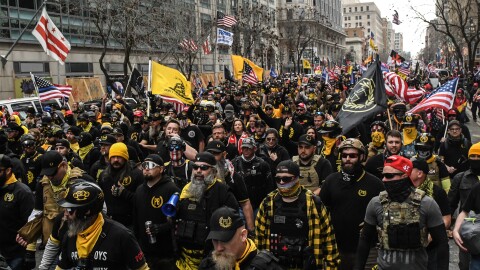Since the Jan. 6 riot at the U.S. Capitol Building, extreme groups and militias across the United States – and how to respond to them – are getting increased attention.
Ohio ranks second in the nation for the highest number of active, extreme anti-government groups, according to a recent report by the Southern Poverty Law Center, which found 566 groups in the United States in 2020. Ohio has 31; only California had more, with 51.
“Ohio has been a state that has had a lot of militias and a lot of people involved in the militia movement for quite a while, really since the 1990s, when the militia movement really got started,” said Karl Kaltenthaler, director of security studies at the University of Akron.
The movement grew in the 1990s, shrank after the Oklahoma City bombing in 1995 and has seen a resurgence since the election of President Barack Obama in 2008, Kaltenthaler said.
The Midwest is a particularly fertile area for such groups. Federal authorities recently arrested militia members from Michigan who were allegedly plotting to arrest Michigan Gov. Gretchen Whitmer. In the aftermath of the Capitol riot, two Central Ohio militia members were arrested and charged with several crimes, including conspiracy.
But there are no reliable estimates about how many people, in Ohio or nationwide, are a part of ant-government militias.
“You can have 100 groups, but if there are two members, it’s quite small,” said Glen Duerr, an assistant professor at Cedarville University, who studies terrorist groups. “In general, the core leadership and the core adherents to any of the groups is fairly small.”
Duerr pointed to a 2019 Ku Klux Klan rally in Dayton where nine members of the group showed up and were met by hundreds of counter-demonstrators as an example of the small number of core supporters of any of these groups.
And Kaltenthaler said national issues, like overturning the results of the presidential election or protecting against possible firearm seizures, don’t usually drive recruitment.
“A lot of the issues are quite localized,” Kaltenthaler said. “For example, in Ohio, one of the things that really plays a role in militias is local economic issues – farm foreclosures, or like in Southeast Ohio, issues with mining or just a general lack of jobs.”
Aside from problems brought on by COVID-19, the U.S. economy is healthier than it was in 2008, so Kaltenthaler thinks the coming years could see a drop in Ohio’s militia activity. And President Joe Biden is less of a polarizing figure and recruitment tool than Obama or the Clintons.
Local authorities and the federal government will have a hard time breaking up militias, if they choose to. For one thing, attempts to force disbanding could add fuel to their anti-government fire.
“I’ve had this conversation with FBI agents,” Kaltenthaler said. “If you go and knock on everybody’s door who is mouthing off, is it the case that you could potentially tip somebody into really going into conspiracy minded overdrive?”
Instead, Kaltenthaler said, authorities should work to gather better intelligence on groups, beyond social media posting and internet chatter, so they can identify groups that are actually a threat.
Duerr argues for some specific steps to head off another event like the Jan. 6 storming of the Capitol.
“I think even mandatory of audits of elections might go a long way,” Duerr said. “Then federal election laws, or web cams in terms of counting [votes]. Things of that nature, I think, will be useful in addition to a law-enforcement approach.”
Copyright 2021 90.3 WCPN ideastream. To see more, visit 90.3 WCPN ideastream. 9(MDA5NTM4MTIyMDE0MTg3NDc2MTVlZjdmNQ001))




